Gorilla Vs Tiger Who Would Win in a Fight, Other Comparisons
Gorillas and tigers, representing strength and prowess in their respective realms, exhibit intriguing differences in biological and physical traits. While gorillas exemplify power in dense forests, tigers, with their unique characteristics, reign as apex predators in various habitats. This analysis explores taxonomy, appearance, size, weight, speed, predatory features, and bite force to assess the potential outcome of a one-on-one confrontation between a gorilla and a tiger.
Gorilla vs Tiger: Who Will Win in a Fight/Physical Confrontation?
In a one-on-one confrontation, a lone tiger is likely to prevail over a solitary gorilla due to its superior size, greater weight, heightened speed, predatory features, and enormous bite force.
I). Size and Weight Advantage:
– Tigers, being larger and heavier than gorillas, establish a considerable advantage in one-on-one confrontations, utilizing their size to overpower their counterparts.
II). Speed Advantage:
– Tigers exhibit superior speed compared to gorillas, enabling them to maneuver swiftly and gain a tactical edge in physical confrontations.
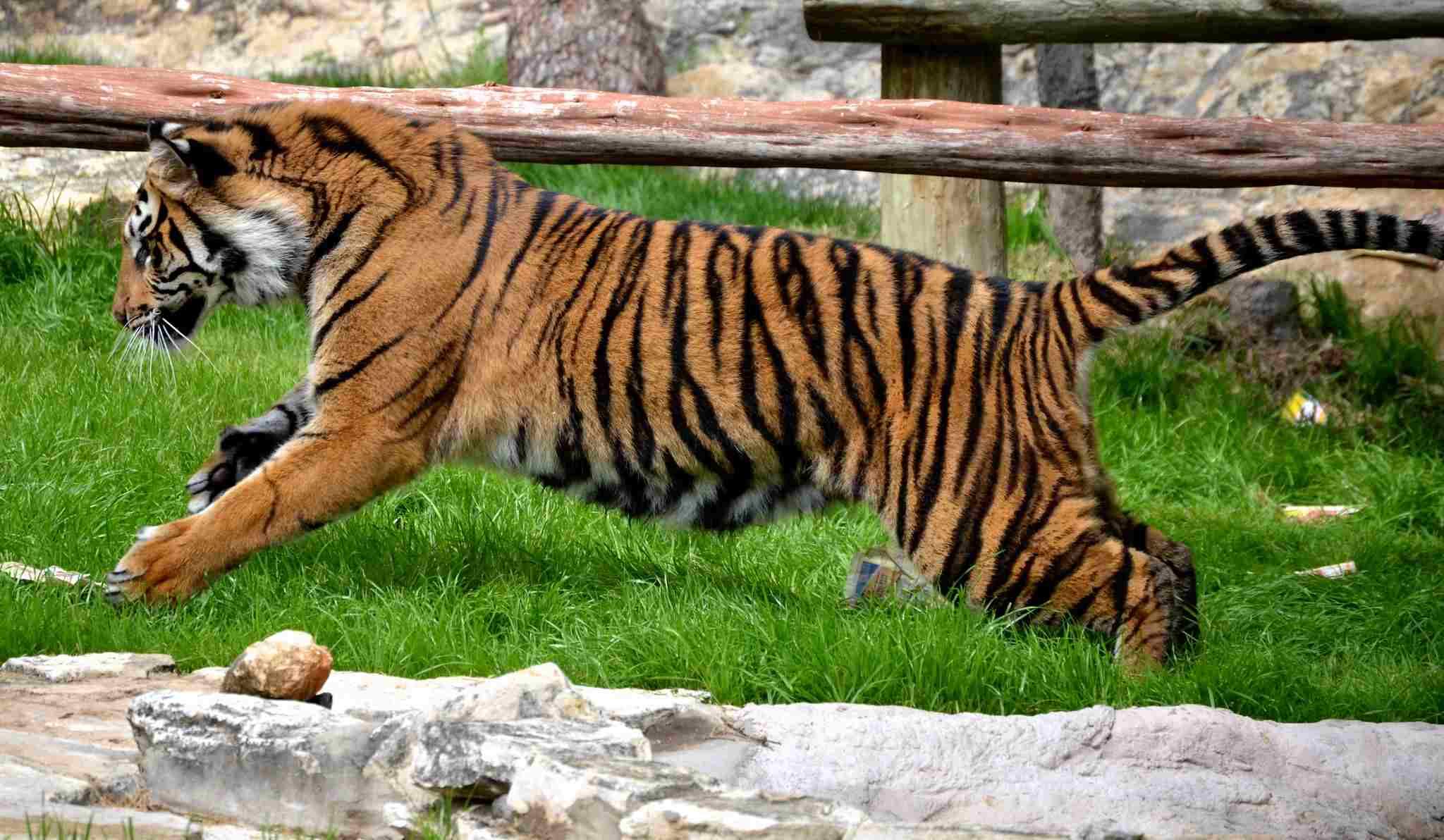
III). Predatory Features:
– Equipped with specialized predatory features, including sharp claws and a keen sense of hunting, tigers possess the tools to subdue and outmaneuver opponents.
IV). Enormous Bite Force:
– Tigers boast an enormous bite force, allowing them to deliver devastating bites that can incapacitate and control their prey effectively.
*Details of Comparison
| Aspect | Gorilla | Tiger |
| Taxonomy | Primates, Hominidae, Gorilla |
Carnivora, Felidae, Panthera, Panthera tigris
|
| Appearance | Robust, black/brown hair, silverback males |
Sleek, orange fur with black stripes
|
| Size | 1.7–1.8 meters (males) | 2.2–3.5 meters |
| Weight | 135–180 kg (males) |
65–306 kg (males)
|
| Bite Force | 1,300–1,500 psi | ~1,000 psi |
| Offensive Advantages | Strong limbs, gripping |
Sharp claws, teeth, speed
|
| Defensive Advantages | Thick skin, social structure |
Camouflage, agility, evasion
|
| Speed | Up to 20 mph |
30–40 mph (short sprints)
|
| Agility | Moderate, tree climbing |
Exceptional, stalking
|
| Overall Physical Capacity | Herbivorous, strong and agile |
Carnivorous, streamlined for hunting
|
| Habitat Preference(s) | Tropical forests |
Various ecosystems, adaptable
|
| Tracks | Handprints, footprints, knuckle-walking |
Paw prints, retractable claws
|
| Lifespan | 35–50 years (wild), up to 60 years (captive) |
10–15 years (wild), up to 20+ years (captive)
|
| Feeding | Herbivores, fruits, leaves |
Carnivores, large ungulates, mammals
|
| Social Behavior | Highly social, family groups |
Solitary, territorial, marking
|
| Reproduction | Polygynous, gestation ~8.5 months |
Polygynous, gestation ~93–112 days, 2–4 cubs
|
| Parental Behavior | Cooperative parenting, strong maternal bonds |
Independent parenting, maternal defense
|
| Proximity to Humans | Remote forests, infrequent encounters |
Human-tiger conflicts in various habitats
|
| Behavior Toward Humans | Shy, defensive if threatened |
Generally avoidant, may be aggressive
|
| Danger Posed to Humans | Rarely poses direct threat |
Can pose a significant danger if threatened
|
| Precautions | Conservation efforts, responsible tourism |
Habitat protection, anti-poaching measures
|
| Conservation Status | Endangered (both species) |
Varies among subspecies, endangered or critically endangered
|
| Conclusion |
Both face habitat loss, poaching, and conservation challenges. Conservation is vital for their survival.
|
1. Taxonomy:
Gorilla:
Kingdom: Animalia
Phylum: Chordata
Class: Mammalia
Order: Primates
Family: Hominidae
Genus: Gorilla
Species: There are two species – Gorilla gorilla (Western gorilla) and Gorilla beringei (Eastern gorilla).
Tiger:
Kingdom: Animalia
Phylum: Chordata
Class: Mammalia
Order: Carnivora
Family: Felidae
Genus: Panthera
Species: Panthera tigris
These classifications highlight the distinct evolutionary paths that led to the development of gorillas and tigers.
2. Appearance:
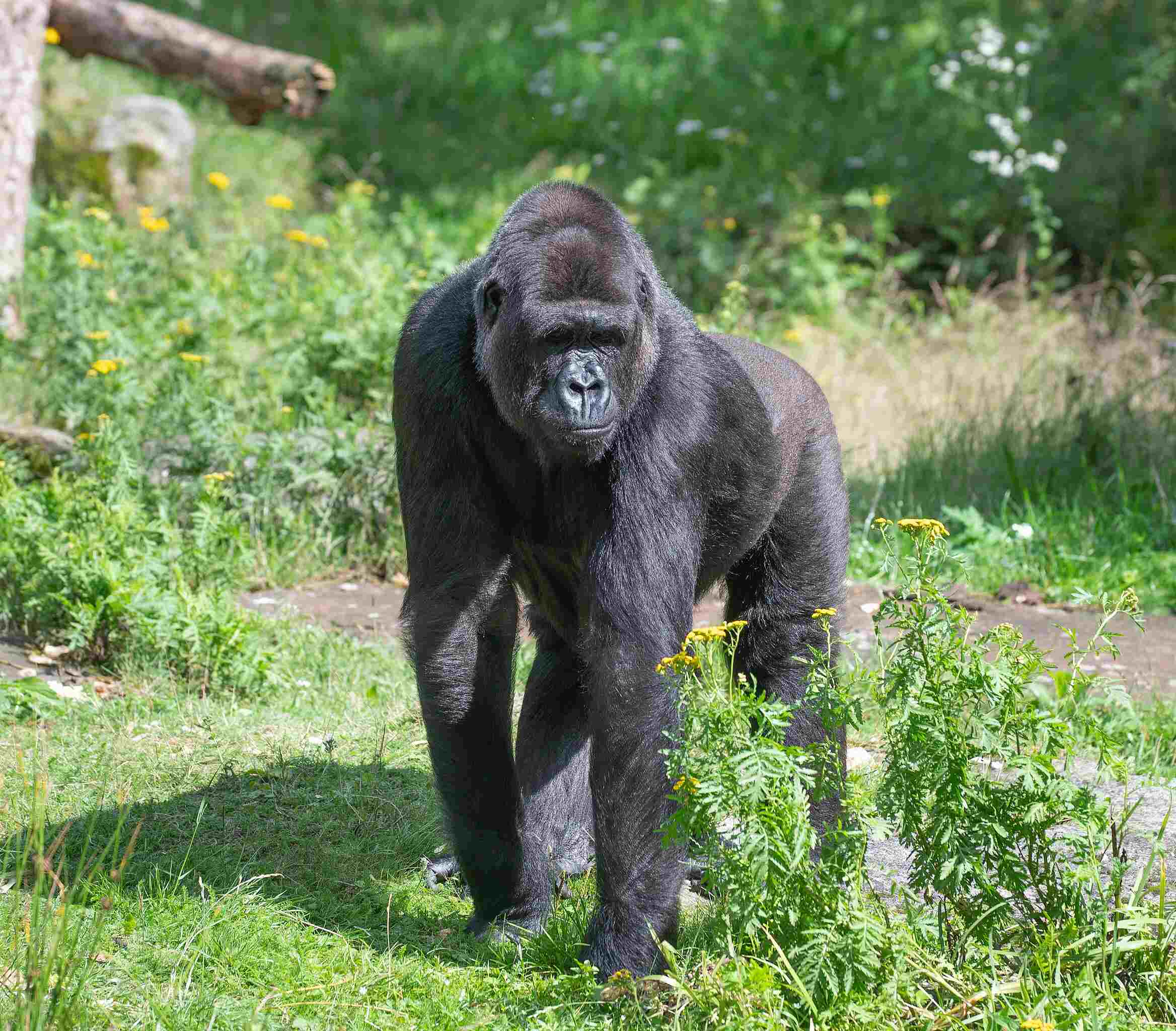
Gorilla:
Robust, with a prominent sagittal crest on the skull (more pronounced in males).
Covered in coarse, black to brown hair.
Males exhibit silver hairs on their back, giving rise to the term “silverback.”
Tiger:
Slender, powerful body with a distinctive coat featuring orange fur with black stripes.
White tigers, a color variant, exist due to a genetic mutation.
Striking appearance aids in camouflage in their natural habitats.
Comparison:
Gorillas have a more robust and dark-colored appearance, emphasizing their terrestrial lifestyle.
Tigers display a sleeker build with a striking striped pattern, contributing to effective camouflage in their environments.
Ecological Implications:
Gorilla appearances are adapted to forested environments, providing camouflage amidst vegetation.
Tiger markings offer a crucial advantage in their habitats, aiding in both hunting and avoiding predators.
3. Size:
Gorilla:
Adult males: 1.7–1.8 meters (5.6–5.9 feet) when standing upright.
Adult females: Generally smaller than males.
Tiger:
Length: 2.2–3.5 meters (7.2–11.5 feet), excluding the tail.
Males are significantly larger than females.
Comparison:
Tigers are generally larger than gorillas, reflecting their different ecological roles as predators.
Ecological Implications:
Tiger size contributes to their role as apex predators, influencing prey behavior and ecosystem dynamics.
Gorilla size is adapted to their herbivorous lifestyle, impacting plant communities through foraging patterns.
4. Weight:
Gorilla:
Adult males: 135–180 kg (298–397 lbs).
Adult females: 68–113 kg (150–249 lbs).
Tiger:
Weight: 65–306 kg (143–675 lbs), with males being heavier than females.
Comparison:
Tigers, being carnivores, have a wider weight range, with some individuals significantly heavier than gorillas.
Ecological Implications:
Gorilla weight influences their foraging habits, impacting vegetation density and diversity.
Tiger weight is crucial for hunting and maintaining a balanced predator-prey relationship in their ecosystems.
5. Bite Force:
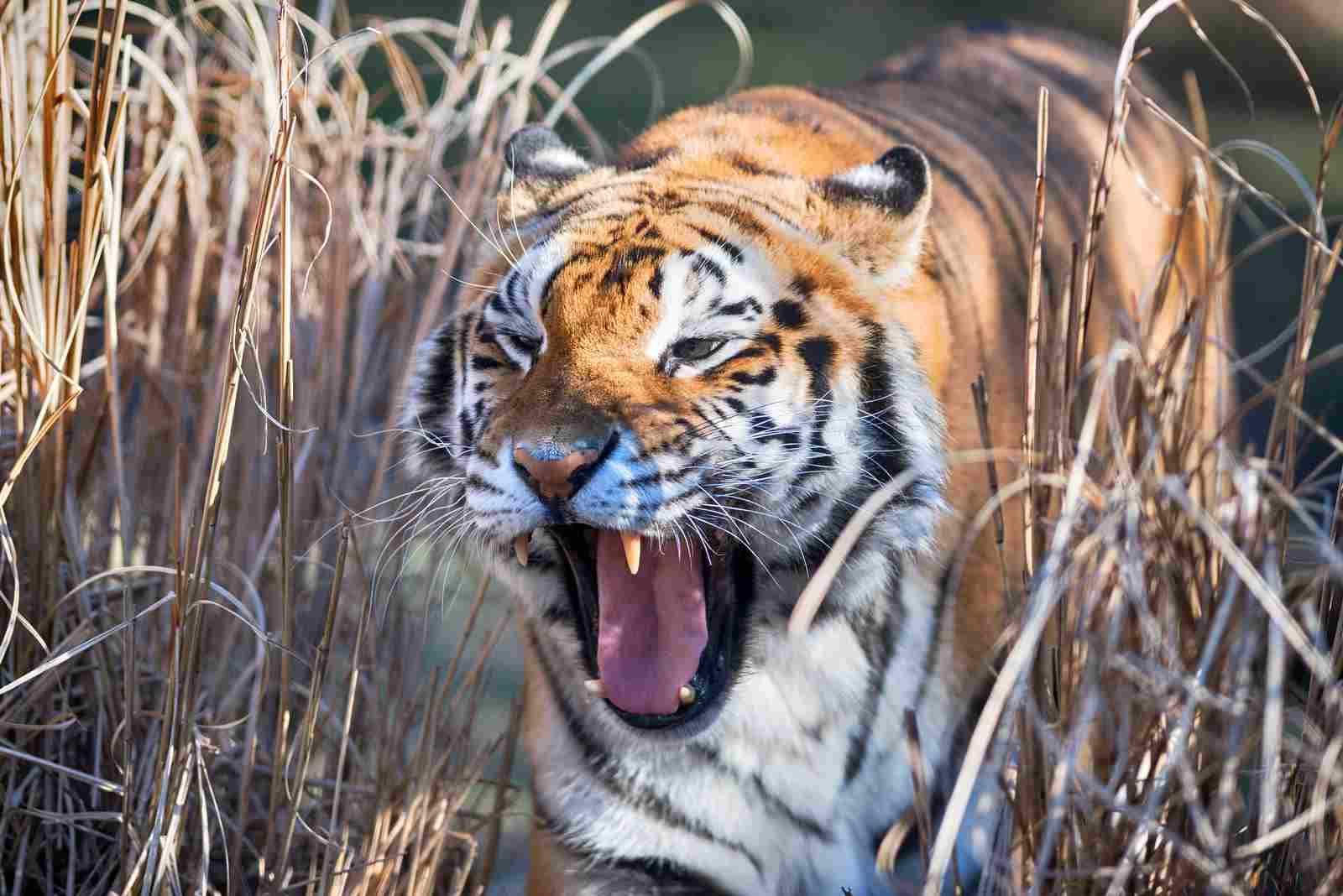
Gorilla:
Estimated to have a bite force of around 1,300 to 1,500 pounds per square inch (psi).
Used primarily for consuming vegetation, fruits, and occasional small animals.
Tiger:
Possesses a powerful bite force of approximately 1,000 psi.
Adapted for gripping and subduing large prey during hunting.
Comparison:
Gorillas exhibit a slightly stronger bite force, reflecting their omnivorous diet and the need to process tough plant materials.
Tigers have a formidable bite force well-suited for capturing and subduing prey.
Ecological Implications:
Gorilla bite force influences their role in seed dispersal within their habitat.
Tiger bite force is essential for hunting and maintaining balance in prey populations.
6. Physical Offensive Advantages:
Gorilla:
Powerful limbs and upper body strength.
Can use hands for striking and gripping.
Tiger:
Sharp claws and teeth.
Exceptional speed and agility for effective hunting.
Comparison:
Gorillas rely on physical strength and close-quarters combat for defense or competition.
Tigers employ agility and predatory adaptations for offensive strategies.
Ecological Implications:
Gorilla physical strength influences their dominance hierarchy and territorial disputes.
Tiger offensive advantages contribute to their role as top predators, influencing prey behavior and maintaining ecosystem balance.
7. Physical Defensive Advantages:
Gorilla:
Thick, tough skin.
Social structure with alpha males providing protection.
Tiger:
Camouflage coat for concealment.
Quick reflexes and agility for evading threats.
Comparison:
Gorillas rely on social structures and physical attributes for defense.
Tigers employ camouflage, agility, and evasion tactics.
Ecological Implications:
Gorilla defenses contribute to group cohesion and protection against predators.
Tiger defensive strategies play a crucial role in maintaining their status as apex predators in their habitats.
8. Speed:
Gorilla:
Can reach speeds up to 20 miles per hour for short bursts.
Tiger:
Exceptional speed, capable of reaching 30–40 miles per hour in short sprints.
Comparison:
Tigers are generally faster, reflecting their predatory nature and the need for quick pursuits.
Gorillas exhibit moderate speed, suited for their terrestrial lifestyle.
Ecological Implications:
Tiger speed is essential for effective hunting and capturing prey.
Gorilla speed contributes to their ability to navigate their habitat and escape potential threats.
9. Agility:

Gorilla:
Moderate agility, enhanced by their powerful limbs.
Tree climbing ability, especially in younger individuals.
Tiger:
Exceptional agility, crucial for stalking, ambushing, and navigating varied terrains.
Comparison:
Tigers exhibit superior agility, vital for their predatory lifestyle and ambushing prey.
Gorillas possess agility adapted to their forested habitats, aiding in navigation and foraging.
Ecological Implications:
Tiger agility is a key factor in successful hunting, influencing prey selection and population dynamics.
Gorilla agility supports their arboreal activities and efficient movement in dense vegetation.
10. Overall Physical Capacity:
Gorilla:
Powerful and robust physique, adapted for ground and tree-based activities.
Specialized for herbivorous diet but with physical strength for self-defense.
Tiger:
Streamlined body, well-suited for hunting and capturing prey.
Carnivorous adaptations, including sharp claws and teeth.
Comparison:
Gorillas exhibit a combination of strength and agility adapted to their omnivorous lifestyle.
Tigers possess a predatory physique, emphasizing speed and stealth.
Ecological Implications:
Gorilla physical capacity influences their role in seed dispersal and habitat maintenance.
Tiger physical adaptations are crucial for maintaining balance in prey populations and ecosystems.
11. Habitat Preference(s):
Gorilla:
Primarily found in tropical and subtropical forests.
Prefer dense vegetation and often inhabit lowland and montane forests.
Tiger:
Inhabit a range of ecosystems including grasslands, mangrove swamps, and dense forests.
Display adaptability to various habitats, including cold climates.
Comparison:
Gorillas have a specific preference for dense, tropical forests, adapting to arboreal and terrestrial life.
Tigers display a broader habitat range, reflecting their ability to thrive in diverse environments.
Ecological Implications:
Gorilla habitat preferences influence vegetation dynamics and seed dispersal in tropical forests.
Tiger adaptability contributes to their role as apex predators in different ecosystems.
12. Tracks:
Gorilla:
Distinctive handprints and footprints.
Generally, knuckle-walkers, leaving characteristic imprints.
Tiger:
Paw prints with retractable claws visible.
Stride length reflects their powerful and efficient movement.
Comparison:
Gorilla tracks highlight their knuckle-walking gait and hand morphology.
Tiger tracks reveal paw features, indicative of a large feline predator.
Ecological Implications:
Gorilla tracks contribute to monitoring their presence and movement in dense habitats.
Tiger tracks are crucial for tracking and studying their territorial behaviors in various ecosystems.
13. Lifespan:
Gorilla:
Wild gorillas typically live around 35 to 50 years.
Captive gorillas may have a slightly longer lifespan, reaching up to 60 years.
Tiger:
Wild tigers generally live around 10 to 15 years.
Captive tigers may live longer, with some reaching 20 years or more.
Comparison:
Gorillas generally have a longer lifespan compared to tigers, both in the wild and captivity.
Ecological Implications:
Gorilla lifespans influence their role in long-term social structures and potential impacts on vegetation over time.
Tiger shorter lifespans contribute to population dynamics and predator-prey relationships in their ecosystems.
14. Mode of Feeding:
Gorilla:
Primarily herbivores, consuming fruits, leaves, stems, and occasionally insects.
Spend a significant portion of the day foraging for plant-based foods.
Tiger:
Carnivores with a diet mainly consisting of large ungulates (deer, wild boar), smaller mammals, and occasionally birds.
Hunt and consume prey to meet their nutritional needs.
Comparison:
Gorillas are herbivores, relying on plant-based diets.
Tigers are obligate carnivores, depending on animal protein for sustenance.
Ecological Implications:
Gorilla feeding habits influence plant communities and seed dispersal in their habitats.
Tiger carnivorous diets impact prey populations, influencing the structure of their ecosystems.
15. Social Behavior:
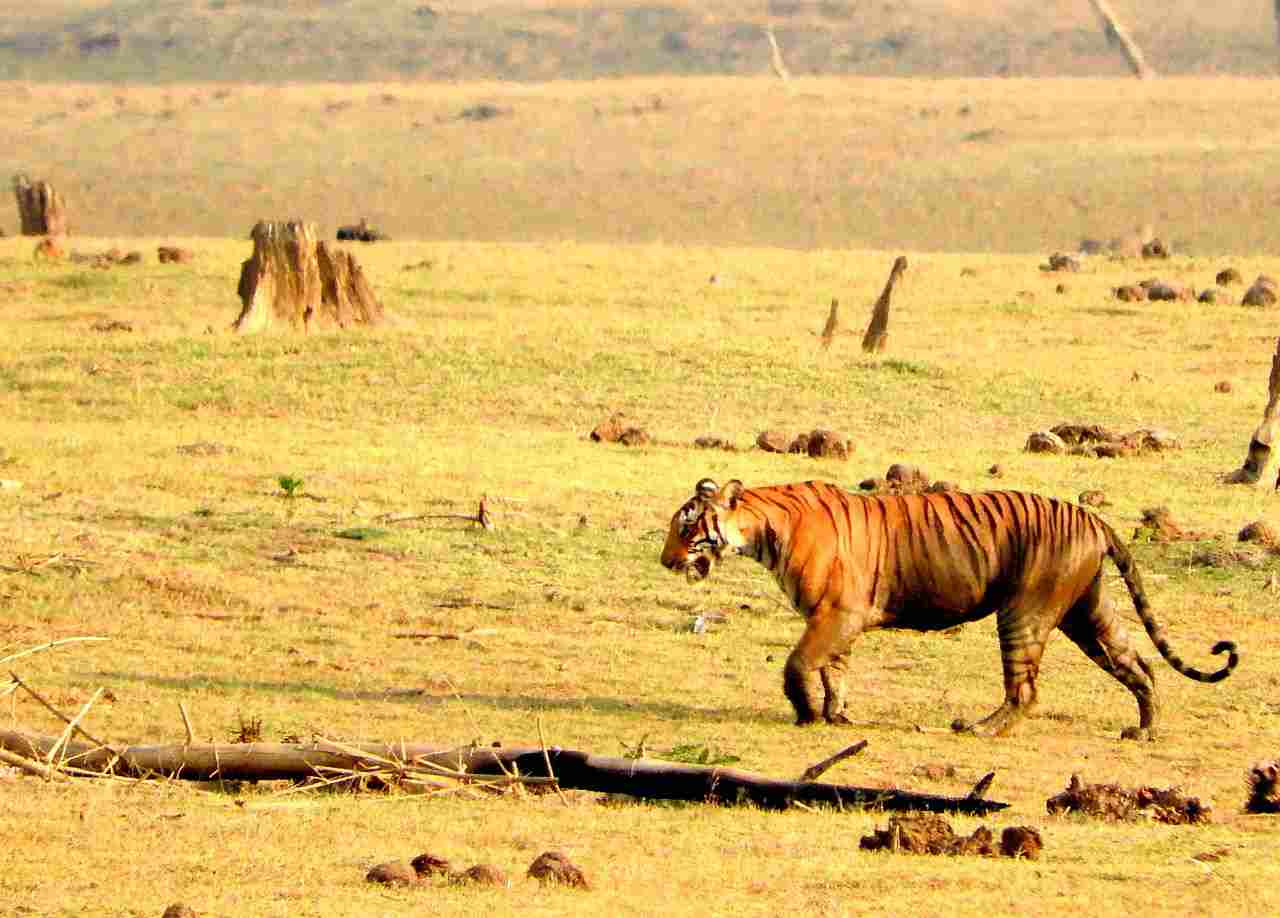
Gorilla:
Live in stable family groups led by a dominant silverback male.
Group dynamics include females, juveniles, and infants.
Tiger:
Generally solitary animals, except during mating or when females raise cubs.
Territories are marked and defended by individuals.
Comparison:
Gorillas are highly social, emphasizing family bonds and cooperative behaviors.
Tigers are typically solitary, reflecting their individualistic and territorial nature.
Ecological Implications:
Gorilla social structures impact group dynamics, influencing territorial behaviors and resource utilization.
Tiger solitary behavior contributes to maintaining territories, reducing competition within their ecosystems.
16. Mode of Reproduction:
Gorilla:
Polygynous mating system, where dominant males have multiple mates.
Gestation period is about 8.5 months, and females give birth to a single offspring.
Tiger:
Polygynous mating, with males having multiple mates.
Gestation lasts approximately 93–112 days, and litters usually consist of 2-4 cubs.
Comparison:
Both species exhibit polygynous mating systems, but gorillas typically have fewer offspring per birth compared to tigers.
Ecological Implications:
Gorilla reproductive patterns influence population dynamics and social structures within groups.
Tiger reproductive strategies contribute to maintaining genetic diversity and predator-prey relationships in their habitats.
17. Parental Behavior:
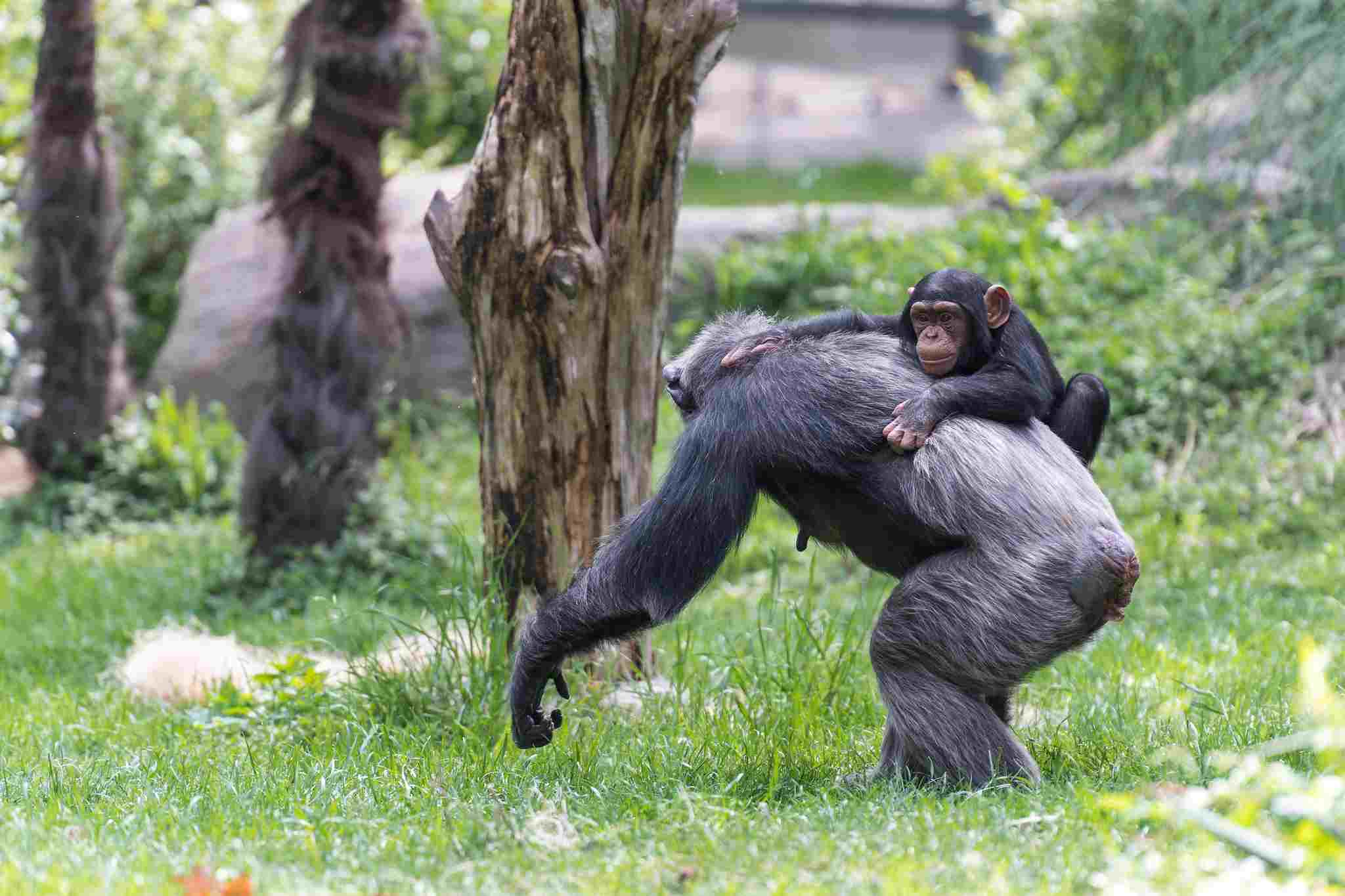
Gorilla:
Strong maternal bonds, with females caring for their offspring.
Silverback males play a protective role and may intervene in conflicts.
Tiger:
Females are solely responsible for raising and protecting cubs.
Male tigers may pose a threat to cubs, and the mother defends them fiercely.
Comparison:
Gorillas exhibit a cooperative parenting approach with both males and females contributing to the care of offspring.
Tigers have a more independent parenting style, with the mother taking the primary responsibility for cub rearing.
Ecological Implications:
Gorilla cooperative parenting supports the well-being of offspring and contributes to group dynamics.
Tiger maternal protection is crucial for cub survival, influencing population dynamics.
18. Proximity to Human-Inhabited Areas:
Gorilla:
Found in remote and dense forests, often far from human settlements.
Encounters with humans are relatively infrequent.
Tiger:
Human-tiger conflicts can arise when tigers encroach on agricultural lands or settlements.
Habitat loss and fragmentation contribute to increased proximity to human activities.
Comparison:
Gorillas generally inhabit areas less affected by direct human influence compared to tigers.
Ecological Implications:
Human-gorilla interactions are limited, reducing direct threats to their populations.
Human-tiger conflicts pose challenges for both tiger conservation and human safety.
19. Behavior Toward Humans:
Gorilla:
Typically shy and avoid direct confrontation with humans.
May display defensive behaviors if they feel threatened.
Tiger:
Wild tigers generally avoid humans but may become more aggressive in certain situations.
Some tigers in captivity may exhibit different behaviors due to human interaction.
Comparison:
Both species generally avoid confrontations with humans, but tigers may be more prone to aggression in specific circumstances.
Ecological Implications:
Human-avoidance behaviors in both species contribute to their survival by reducing conflicts and potential threats.
20. Danger Posed to Humans:
Gorilla:
Rarely pose a direct threat to humans.
More likely to exhibit defensive behaviors if humans approach closely.
Tiger:
Wild tigers can pose a significant danger if they feel threatened or cornered.
Responsible for a notable number of human-wildlife conflicts.
Comparison:
While both species can potentially pose risks, tigers are generally considered more dangerous due to their predatory nature.
Ecological Implications:
Human-gorilla conflicts are minimal, reducing direct threats to human safety.
Human-tiger conflicts emphasize the need for conservation strategies to mitigate risks and protect both humans and tigers.
21. Associated Precautions:
Gorilla:
Conservation efforts focus on protecting their natural habitats from deforestation and human encroachment.
Encouraging responsible tourism to minimize disturbances to gorilla populations.
Tiger:
Conservation strategies include habitat protection, anti-poaching measures, and initiatives to reduce human-tiger conflicts.
Promoting awareness about the importance of preserving tiger habitats and the role of these apex predators in ecosystems.
Comparison:
Both species require conservation efforts to address threats to their populations, including habitat loss and human-wildlife conflicts.
Ecological Implications:
Conservation actions for gorillas and tigers contribute to maintaining biodiversity and ecological balance in their respective habitats.
22. Conservation Status:
Gorilla:
Western Gorilla (Gorilla gorilla): Endangered
Eastern Gorilla (Gorilla beringei): Endangered
Threats include habitat loss, poaching, and diseases like Ebola affecting their populations.
Tiger:
Conservation status varies among subspecies, with some classified as endangered or critically endangered.
Threats include habitat loss, poaching for their body parts, and human-wildlife conflicts.
Comparison:
Both gorillas and tigers face significant conservation challenges, primarily driven by human activities impacting their habitats and well-being.
Ecological Implications:
Successful conservation measures are essential to preserving these species and maintaining the ecological balance in their respective ecosystems.
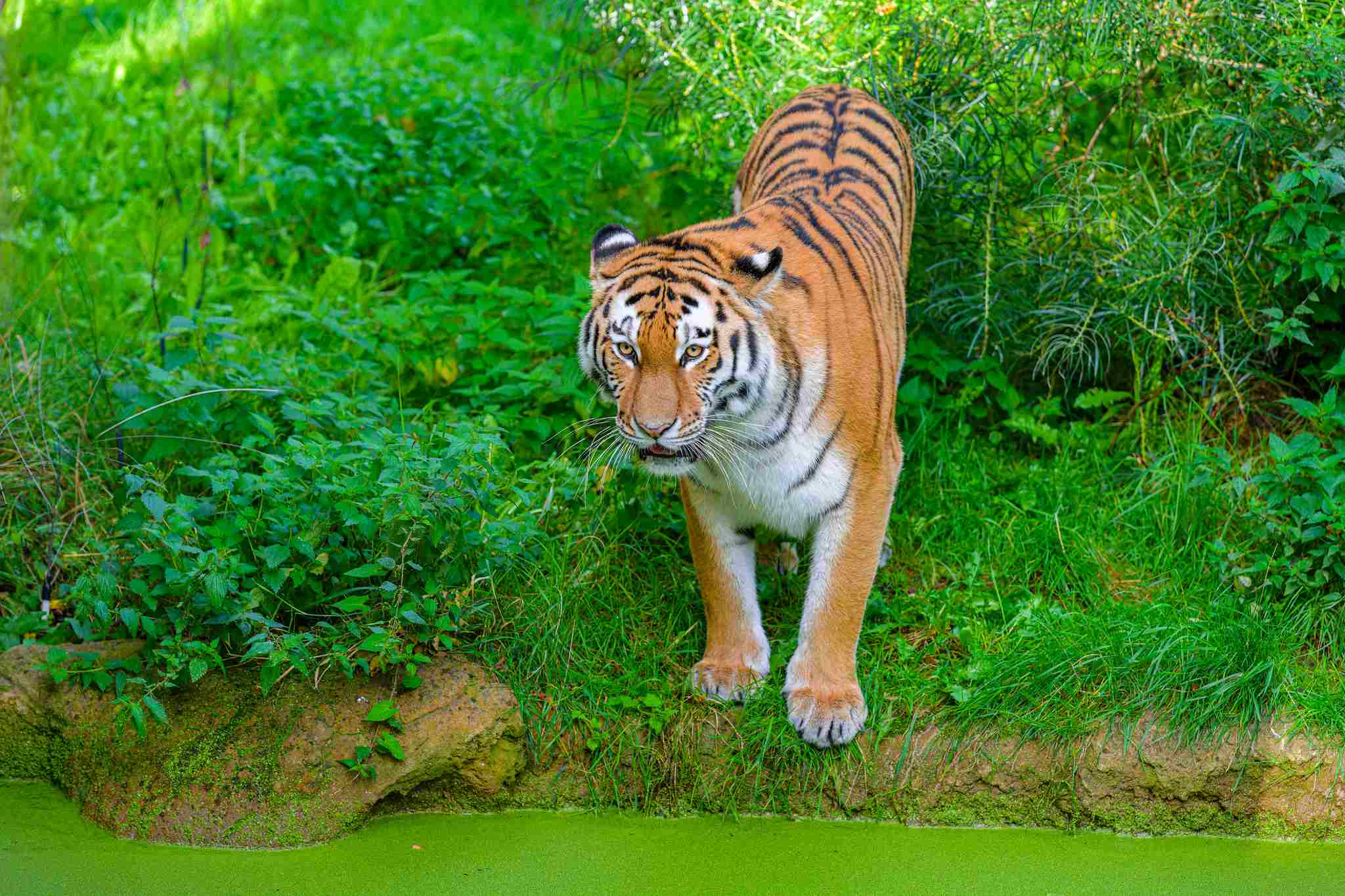
Summary of Comparison
Taxonomy:
Gorilla: Primates, Hominidae, Gorilla
Tiger: Carnivora, Felidae, Panthera, Panthera tigris
Appearance:
Gorilla: Robust, black/brown hair, silverback males
Tiger: Sleek, orange fur with black stripes
Size:
Gorilla: 1.7–1.8 meters (males)
Tiger: 2.2–3.5 meters
Weight:
Gorilla: 135–180 kg (males)
Tiger: 65–306 kg (males)
Bite Force:
Gorilla: 1,300–1,500 psi
Tiger: ~1,000 psi
Physical Advantages:
Gorilla: Strong limbs, gripping
Tiger: Sharp claws, teeth, speed
Defensive Advantages:
Gorilla: Thick skin, social structure
Tiger: Camouflage, agility, evasion
Speed:
Gorilla: Up to 20 mph
Tiger: 30–40 mph (short sprints)
Agility:
Gorilla: Moderate, tree climbing
Tiger: Exceptional, stalking
Overall Physical Capacity:
Gorilla: Herbivorous, strong, and agile
Tiger: Carnivorous, streamlined for hunting
Habitat Preference(s):
Gorilla: Tropical forests
Tiger: Various ecosystems, adaptable
Tracks:
Gorilla: Handprints, footprints, knuckle-walking
Tiger: Paw prints, retractable claws
Lifespan:
Gorilla: 35–50 years (wild), up to 60 years (captive)
Tiger: 10–15 years (wild), up to 20+ years (captive)
Feeding:
Gorilla: Herbivores, fruits, leaves
Tiger: Carnivores, large ungulates, mammals
Social Behavior:
Gorilla: Highly social, family groups
Tiger: Solitary, territorial, marking
Reproduction:
Gorilla: Polygynous, gestation ~8.5 months
Tiger: Polygynous, gestation ~93–112 days, 2–4 cubs
Parental Behavior:
Gorilla: Cooperative parenting, strong maternal bonds
Tiger: Independent parenting, maternal defense
Proximity to Humans:
Gorilla: Remote forests, infrequent encounters
Tiger: Human-tiger conflicts in various habitats
Behavior Toward Humans:
Gorilla: Shy, defensive if threatened
Tiger: Generally avoidant, may be aggressive
Danger Posed to Humans:
Gorilla: Rarely poses a direct threat
Tiger: Can pose a significant danger if threatened
Precautions:
Gorilla: Conservation efforts, responsible tourism
Tiger: Habitat protection, anti-poaching measures
Conservation Status:
Both are endangered, emphasizing the need for effective conservation.
Conclusion:
I. Similarities:
Both gorillas and tigers face threats from habitat loss, poaching, and human-wildlife conflicts.
Conservation efforts are crucial for the survival of both species, emphasizing the need to protect their natural habitats.
II. Differences:
Gorillas are herbivores with a more social structure, whereas tigers are carnivores with a solitary nature.
The ecological implications of their behaviors highlight their distinct roles in shaping the ecosystems they inhabit.
Conservation strategies must be tailored to the specific challenges each species faces to ensure their long-term survival in the wild.



